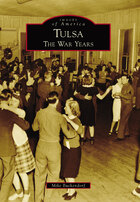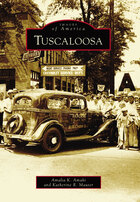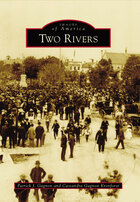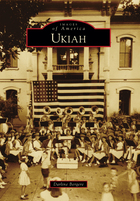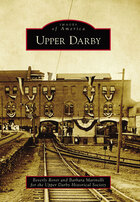Browse Titles - 1244 results
5. Civil Defense and Community Life
written by Mike Buckendorf; in Tulsa: The War Years, Images of America (Charleston, SC: Arcadia Publishing, 2011), 79-96
Still reeling from the hungry days of the Great Depression, America was ill-equipped when the nation entered the Second World War. Referred to as the “sleeping giant” by the Japanese, the United States awoke from its slumber with a vengeance and soon began creating a veritable tidal wave of production that tur...
Sample
written by Mike Buckendorf; in Tulsa: The War Years, Images of America (Charleston, SC: Arcadia Publishing, 2011), 79-96
Description
Still reeling from the hungry days of the Great Depression, America was ill-equipped when the nation entered the Second World War. Referred to as the “sleeping giant” by the Japanese, the United States awoke from its slumber with a vengeance and soon began creating a veritable tidal wave of production that turned the country into the “Arsenal of Democracy.” Tulsa, Oklahoma, was one of the cities at the forefront of this massive wartime bu...
Still reeling from the hungry days of the Great Depression, America was ill-equipped when the nation entered the Second World War. Referred to as the “sleeping giant” by the Japanese, the United States awoke from its slumber with a vengeance and soon began creating a veritable tidal wave of production that turned the country into the “Arsenal of Democracy.” Tulsa, Oklahoma, was one of the cities at the forefront of this massive wartime buildup. From bomber plants to aviation training schools, to civil defense and the construction of military bases, to the thousands who served in uniform across Europe and the Pacific, Tulsa gave everything it had and then some. This was a different breed of people that nonetheless stood firm in the face of adversity and came together as a community. Tulsa: The War Years takes the reader back to the time when people did without for the greater benefit of all and sometimes sacrificed everything for the sake of victory.
Show more
Show less
Field of Study
American History
Content Type
Book
Author / Creator
Mike Buckendorf
Date Published / Released
2011
Publisher
Arcadia Publishing
Series
Images of America
Topic / Theme
Government agencies, Town life, Public safety occupations, World War II, 1939-1945
Copyright Message
Copyright © 2011 by Mike Buckendorf
×
2. Church and State
written by Amalia K. Amaki and Katherine Mauter; in Tuscaloosa, Images of America (Charleston, SC: Arcadia Publishing, 2012), 21-36
Tuscaloosa (Choctaw for “black warrior”) is one of the oldest cities in West Alabama. It shares its name with a chief who fought Spanish conquistador Hernando de Soto in 1540 and a river that stretches from the Appalachian foothills in the north-central region to the floodplain and lowlands of the south. Calle...
Sample
written by Amalia K. Amaki and Katherine Mauter; in Tuscaloosa, Images of America (Charleston, SC: Arcadia Publishing, 2012), 21-36
Description
Tuscaloosa (Choctaw for “black warrior”) is one of the oldest cities in West Alabama. It shares its name with a chief who fought Spanish conquistador Hernando de Soto in 1540 and a river that stretches from the Appalachian foothills in the north-central region to the floodplain and lowlands of the south. Called “The Druid City” since the 1800s, when large water oaks lined its main streets, Tuscaloosa remains a center of industry, commerce...
Tuscaloosa (Choctaw for “black warrior”) is one of the oldest cities in West Alabama. It shares its name with a chief who fought Spanish conquistador Hernando de Soto in 1540 and a river that stretches from the Appalachian foothills in the north-central region to the floodplain and lowlands of the south. Called “The Druid City” since the 1800s, when large water oaks lined its main streets, Tuscaloosa remains a center of industry, commerce, health care, education, and cultural life, with the university being its dominant source. The former capital (from 1826 to 1846) is affiliated with the Alabama Crimson Tide, catfish, Dreamland, the Black Warrior River, a strong folk and craft tradition, and Gov. George Wallace's 1963 “stand at the schoolhouse door.”
Show more
Show less
Field of Study
American History
Content Type
Book
Author / Creator
Amalia K. Amaki, Katherine Mauter
Date Published / Released
2012
Publisher
Arcadia Publishing
Series
Images of America
Topic / Theme
State and provincial government, Municipal government, Places of worship
Copyright Message
Copyright © 2011 by Amalia K. Amaki and Katherine R. Mauter
×
7. Government Buildings and Services in Tuscarawas County
written by Fred Miller; in Tuscarawas County, Images of America (Charleston, SC: Arcadia Publishing, 2000), 121-128
Although comprised of only 18 communities, Tuscarawas County, Ohio boasts a long and varied history. Incorporated in 1808, it is rich in Native American and early pioneer lore. It is the birthplace of the first pioneer settlement in the Ohio Country (1772-1777), and was home to the only Revolutionary War Fort in t...
Sample
written by Fred Miller; in Tuscarawas County, Images of America (Charleston, SC: Arcadia Publishing, 2000), 121-128
Description
Although comprised of only 18 communities, Tuscarawas County, Ohio boasts a long and varied history. Incorporated in 1808, it is rich in Native American and early pioneer lore. It is the birthplace of the first pioneer settlement in the Ohio Country (1772-1777), and was home to the only Revolutionary War Fort in the state, erected in 1778 near Bolivar, Ohio. Baseball great Cy Young was born and is buried here. The Society of Separatists of Zoar e...
Although comprised of only 18 communities, Tuscarawas County, Ohio boasts a long and varied history. Incorporated in 1808, it is rich in Native American and early pioneer lore. It is the birthplace of the first pioneer settlement in the Ohio Country (1772-1777), and was home to the only Revolutionary War Fort in the state, erected in 1778 near Bolivar, Ohio. Baseball great Cy Young was born and is buried here. The Society of Separatists of Zoar experimented with one of the most successful endeavors in communal living in American history. Coal mines, a significant source of employment for residents of the county, dotted the countryside. The Ohio Erie Canal, which ran the entire length of the county, provided transportation for area goods and people. Major flooding in 1913 caused intensive damage to low-lying settlements. More recently, archaeological expeditions have sketched an image of early life in these communities, and have even uncovered a Revolutionary War Burial Site.
Show more
Show less
Field of Study
American History
Content Type
Book
Author / Creator
Fred Miller
Date Published / Released
2000
Publisher
Arcadia Publishing
Series
Images of America
Topic / Theme
Government buildings, Government services
Copyright Message
Copyright © 2000 by Fred Miller
×
7. The Tuskegee Study
written by Amalia K. Amaki and Amelia Boynton Robinson; in Tuskegee, Images of America (Charleston, SC: Arcadia Publishing, 2013), 105-116
Tuskegee, Alabama, is associated with Tuskegee University, the Tuskegee Airmen, Booker T. Washington, and George Washington Carver. Named after the Taskigi, it is the site of the first law school in Alabama and had local schools long before there was a public school system. Tuskegee Normal School for Colored Teach...
Sample
written by Amalia K. Amaki and Amelia Boynton Robinson; in Tuskegee, Images of America (Charleston, SC: Arcadia Publishing, 2013), 105-116
Description
Tuskegee, Alabama, is associated with Tuskegee University, the Tuskegee Airmen, Booker T. Washington, and George Washington Carver. Named after the Taskigi, it is the site of the first law school in Alabama and had local schools long before there was a public school system. Tuskegee Normal School for Colored Teachers (now Tuskegee University) was pivotal to the city being a beacon of African American achievement for a century. The birthplace of c...
Tuskegee, Alabama, is associated with Tuskegee University, the Tuskegee Airmen, Booker T. Washington, and George Washington Carver. Named after the Taskigi, it is the site of the first law school in Alabama and had local schools long before there was a public school system. Tuskegee Normal School for Colored Teachers (now Tuskegee University) was pivotal to the city being a beacon of African American achievement for a century. The birthplace of civil rights icon Rosa Parks, radio host Tom Joyner, and singer Lionel Richie, it is where Olympic star Alice Coachman was dubbed the “Tuskegee Flash” and where important court cases guaranteeing voting rights and equal education were fought. The city was also the site of the infamous medical experiment that threatened to stain the school’s triumphant legacy.
Show more
Show less
Field of Study
American History
Content Type
Book
Author / Creator
Amalia K. Amaki, Amelia Boynton Robinson
Date Published / Released
2013
Publisher
Arcadia Publishing
Series
Images of America
Topic / Theme
Government agencies, Scientific research, Afar
Copyright Message
Copyright © 2013 by Amalia K. Amaki and Amelia Boynton Robinson
×
5. Progressive Citizenship
written by Patrick Gagnon; in Two Rivers, Images of America (Charleston, SC: Arcadia Publishing), 75-90
The heritage of Two Rivers has been shaped by water. The rare conjunction of Lake Michigan with a dual river system compelled the Potawatomi and Menominee as well as the first American settlers. People of the First Nations plied the lake and rivers in search of whitefish, while initial American settlers sought fis...
Sample
written by Patrick Gagnon; in Two Rivers, Images of America (Charleston, SC: Arcadia Publishing), 75-90
Description
The heritage of Two Rivers has been shaped by water. The rare conjunction of Lake Michigan with a dual river system compelled the Potawatomi and Menominee as well as the first American settlers. People of the First Nations plied the lake and rivers in search of whitefish, while initial American settlers sought fish and timber and appreciated the commercial potential of the harbor. Two Rivers rapidly developed into a woodenware manufacturer of wor...
The heritage of Two Rivers has been shaped by water. The rare conjunction of Lake Michigan with a dual river system compelled the Potawatomi and Menominee as well as the first American settlers. People of the First Nations plied the lake and rivers in search of whitefish, while initial American settlers sought fish and timber and appreciated the commercial potential of the harbor. Two Rivers rapidly developed into a woodenware manufacturer of world significance. When native forests diminished, the community demonstrated patterns typical of a small American town. Businesses, schools, churches, and public services grew and thrived. Through periods of growth, decline, and stability, the lake and the rivers have given the community its distinctiveness. Located on a small peninsula almost 90 miles north of Milwaukee, Two Rivers's climate has earned it a reputation as "the coolest spot in Wisconsin."
Show more
Show less
Field of Study
American History
Content Type
Book
Author / Creator
Patrick Gagnon
Publisher
Arcadia Publishing
Series
Images of America
Topic / Theme
Municipal government, Political causes
Copyright Message
Copyright © 2012 by Patrick J. Gagnon and Cassandra Gagnon Kronforst
×
2. Schools, Churches, and Government
written by Darline Bergere; in Ukiah, Images of America (Charleston, SC: Arcadia Publishing, 2009), 35-54
Nestled in the Yokayo Valley, surrounded by coastal ranges, Ukiah officially became a town in 1859 when it broke away from being governed by Sonoma County. Spanish settlers put down roots through land grants and brought their rich culture to the area. Pomo Indians who lived in Ukiah wove baskets, which are collect...
Sample
written by Darline Bergere; in Ukiah, Images of America (Charleston, SC: Arcadia Publishing, 2009), 35-54
Description
Nestled in the Yokayo Valley, surrounded by coastal ranges, Ukiah officially became a town in 1859 when it broke away from being governed by Sonoma County. Spanish settlers put down roots through land grants and brought their rich culture to the area. Pomo Indians who lived in Ukiah wove baskets, which are collectors' items today throughout the world. Vichy Springs Resort, built in the mid-1800s on the outskirts of Ukiah, had many notable visitor...
Nestled in the Yokayo Valley, surrounded by coastal ranges, Ukiah officially became a town in 1859 when it broke away from being governed by Sonoma County. Spanish settlers put down roots through land grants and brought their rich culture to the area. Pomo Indians who lived in Ukiah wove baskets, which are collectors' items today throughout the world. Vichy Springs Resort, built in the mid-1800s on the outskirts of Ukiah, had many notable visitors, including Presidents Grant and Harrison, Mark Twain, Robert Lewis Stevenson, and Jack London. Today Ukiah is a city where people still ride their bicycles, and the high school has a homecoming parade before the big game. Farmers, ranchers, and vineyard owners work side by side. Summer months bring the annual Sunday in the Park free concerts, and the area is home to an active performing-arts community as well as several art galleries.
Show more
Show less
Field of Study
American History
Content Type
Book
Author / Creator
Darline Bergere
Date Published / Released
2009
Publisher
Arcadia Publishing
Series
Images of America
Topic / Theme
Churches, Government buildings, Municipal government, Schools, Towns
Copyright Message
Copyright © 2009 by Darline Bergere
×
1. Leadership and Services
The site for the city of Union, Missouri, was selected in 1825 by three men who were charged with finding a location for a new county seat within three miles of the center of Franklin County. An earlier county seat, Newport, was located on the Missouri River, making it inaccessible to settlers from the southern pa...
Sample
Description
The site for the city of Union, Missouri, was selected in 1825 by three men who were charged with finding a location for a new county seat within three miles of the center of Franklin County. An earlier county seat, Newport, was located on the Missouri River, making it inaccessible to settlers from the southern part of the county. The site the men chose was little more than wilderness. A town sprang up, and Union now boasts a strong retail and in...
The site for the city of Union, Missouri, was selected in 1825 by three men who were charged with finding a location for a new county seat within three miles of the center of Franklin County. An earlier county seat, Newport, was located on the Missouri River, making it inaccessible to settlers from the southern part of the county. The site the men chose was little more than wilderness. A town sprang up, and Union now boasts a strong retail and industrial base, good schools, and East Central College. Over the past few years, a new Judicial Building and County Government Center have greatly added to the town’s appearance. The historic courthouse, built in 1922, has been renovated and is a source of pride that houses the Veterans’ Hall of Honor commemorating veterans of all wars. The images in this book will bring to life the history of Union’s government, business and industry, schools, churches, transportation, events, and some of the people who made it all happen.
Show more
Show less
Field of Study
American History
Content Type
Book
Author / Creator
Sue Blesi
Date Published / Released
2013
Publisher
Arcadia Publishing
Series
Images of America
Topic / Theme
Municipal government, Public safety occupations
Copyright Message
Copyright © 2013 by Sue Blesi
×
8. Society and Service
written by Cliff Thomas Alderman; in Unionville, Images of America (Charleston, SC: Arcadia Publishing), 107-118
Originally known as the Union District or Langdon's Quarter, the village at the western end of Farmington was officially named Unionville by the U.S. Post Office in 1834. Settling along the banks of the Farmington River, Unionville's early residents were an industrious group, diverting water into canals to power n...
Sample
written by Cliff Thomas Alderman; in Unionville, Images of America (Charleston, SC: Arcadia Publishing), 107-118
Description
Originally known as the Union District or Langdon's Quarter, the village at the western end of Farmington was officially named Unionville by the U.S. Post Office in 1834. Settling along the banks of the Farmington River, Unionville's early residents were an industrious group, diverting water into canals to power numerous family-run mills and factories and producing a host of manufactured goods. Although smaller than the neighboring industrial cit...
Originally known as the Union District or Langdon's Quarter, the village at the western end of Farmington was officially named Unionville by the U.S. Post Office in 1834. Settling along the banks of the Farmington River, Unionville's early residents were an industrious group, diverting water into canals to power numerous family-run mills and factories and producing a host of manufactured goods. Although smaller than the neighboring industrial cities of New Britain and Bristol, Unionville gained an extraordinary manufacturing prominence in the Farmington Valley. Through carefully preserved vintage photographs from the Unionville Museum's collections and from private sources, Unionville chronicles the village's resilient spirit throughout its many transformations.
Show more
Show less
Field of Study
American History
Content Type
Book
Author / Creator
Cliff Thomas Alderman
Publisher
Arcadia Publishing
Series
Images of America
Topic / Theme
Municipal government, Social institutions
Copyright Message
Copyright © 2010 by Clifford Thomas Alderman
×
6. Civic Affairs
written by Stuart J. Koblentz and Kate Erstein; in Upper Arlington, Images of America (Charleston, SC: Arcadia Publishing, 2008), 85-94
Upper Arlington was founded by brothers King and Ben Thompson, who purchased farmland in 1913 from James T. Miller. Inspired by the garden city movement, the Thompsons envisioned an idealistic residential community. The brothers engaged William Pitkin Jr., a prominent landscape architect from Rochester, New York,...
Sample
written by Stuart J. Koblentz and Kate Erstein; in Upper Arlington, Images of America (Charleston, SC: Arcadia Publishing, 2008), 85-94
Description
Upper Arlington was founded by brothers King and Ben Thompson, who purchased farmland in 1913 from James T. Miller. Inspired by the garden city movement, the Thompsons envisioned an idealistic residential community. The brothers engaged William Pitkin Jr., a prominent landscape architect from Rochester, New York, to provide the most modern concepts of city planning. Over the years, Upper Arlington annexed land to reach its current boundaries. Upp...
Upper Arlington was founded by brothers King and Ben Thompson, who purchased farmland in 1913 from James T. Miller. Inspired by the garden city movement, the Thompsons envisioned an idealistic residential community. The brothers engaged William Pitkin Jr., a prominent landscape architect from Rochester, New York, to provide the most modern concepts of city planning. Over the years, Upper Arlington annexed land to reach its current boundaries. Upper Arlington has had a Native American trail and a military training camp, and its historic district earned a place on the National Register of Historic Places. The community is still known for gracious living, celebrated schools, and the largest noncommercial Fourth of July parade around. Golfing legend Jack Nicklaus, Ohio State University football coaches Woody Hayes, John Cooper, and Jim Tressel, developer John Galbreath, Ohio governor James Rhodes, and United States senator John Bricker have all called Upper Arlington home.
Show more
Show less
Field of Study
American History
Content Type
Book
Author / Creator
Stuart J. Koblentz, Kate Erstein
Date Published / Released
2008
Publisher
Arcadia Publishing
Series
Images of America
Topic / Theme
Municipal government
Copyright Message
Copyright © 2008 by Stuart J. Koblentz and Kate Erstein on behalf of the Upper Arlington Historical Society
×
7. Service to the Public
written by Beverly Rorer and Barbara Marinelli; in Upper Darby, Images of America (Charleston, SC: Arcadia Publishing, 2011), 111-128
Upper Darby, one of the earliest settlements west of Philadelphia, began with the Lenni Lenape Indians and early Swedish settlers of the 1650s. Mills and farming were fueled by several creeks forming a fall line before dropping off to the Piedmont through Upper Darby. From the beginning, influential families left...
Sample
written by Beverly Rorer and Barbara Marinelli; in Upper Darby, Images of America (Charleston, SC: Arcadia Publishing, 2011), 111-128
Description
Upper Darby, one of the earliest settlements west of Philadelphia, began with the Lenni Lenape Indians and early Swedish settlers of the 1650s. Mills and farming were fueled by several creeks forming a fall line before dropping off to the Piedmont through Upper Darby. From the beginning, influential families left their mark. The descendants of Samuel Sellers were inventors whose skills benefited the nation. Dr. George Smith authored the bill for...
Upper Darby, one of the earliest settlements west of Philadelphia, began with the Lenni Lenape Indians and early Swedish settlers of the 1650s. Mills and farming were fueled by several creeks forming a fall line before dropping off to the Piedmont through Upper Darby. From the beginning, influential families left their mark. The descendants of Samuel Sellers were inventors whose skills benefited the nation. Dr. George Smith authored the bill for Pennsylvania public education, and famous financiers A.J. Drexel and his son A.J. Drexel Jr. created beautiful estates with landscaped vistas where residents enjoyed leisure activities. By the early 1900s, most farms had turned to dairying and became part of “the Butter Belt.” The Sixty-Ninth Street Terminal, built in 1907, was the transportation hub for those going farther west and brought rapid development to the community. Upper Darby chronicles the people and the changing demographics of this thriving area.
Show more
Show less
Field of Study
American History
Content Type
Book
Author / Creator
Beverly Rorer, Barbara Marinelli
Date Published / Released
2011
Publisher
Arcadia Publishing
Series
Images of America
Topic / Theme
Municipal utilities, Municipal government, Public safety occupations
Copyright Message
Copyright © 2011 by Beverly Rorer and Barbara Marinelli for the Upper Darby Historical Society
×

